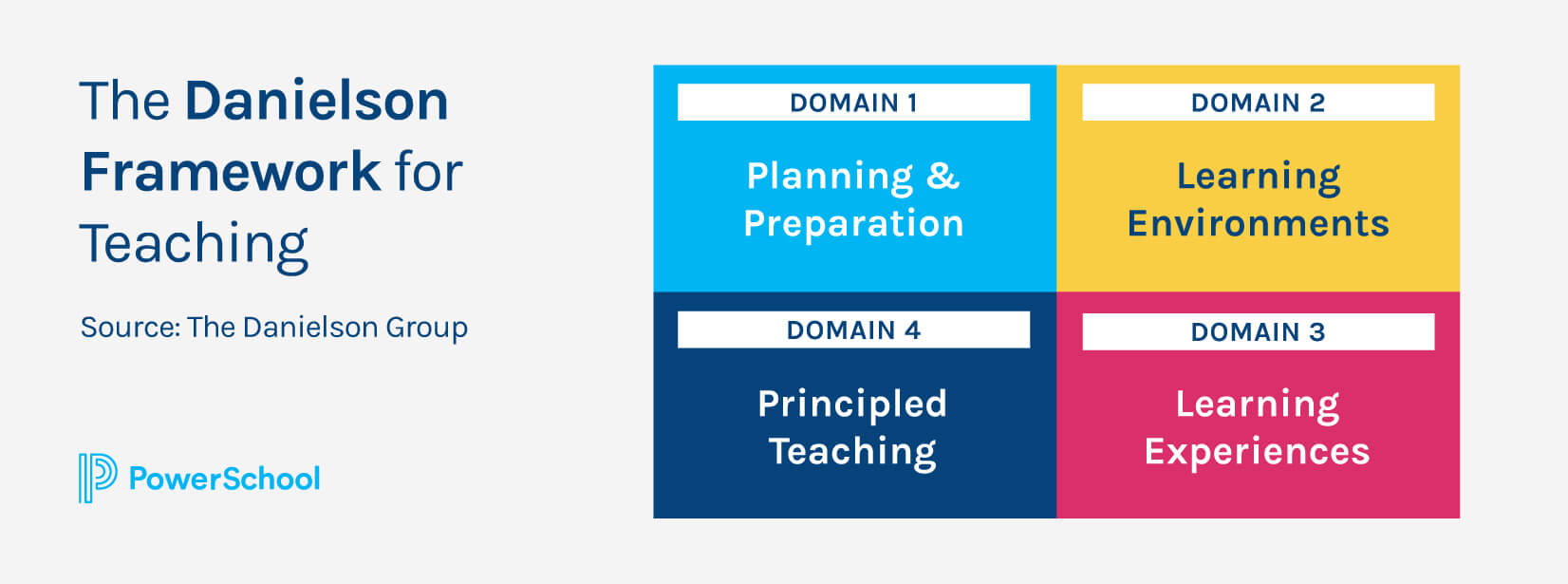K-12 leaders working to improve teacher support can look to The Danielson Group’s Framework for Teaching (FFT) for a proven strategy. This career support model designed for education helps teachers grow their skills and support better student outcomes. The FFT prioritizes self-reflection and collaboration to enable teachers, administrators, and principals to better work together and promote continuous growth.
The collaborative approach to teacher growth offered by the FFT aligns with findings in the PowerSchool Education Focus Report: Top District Priorities and Shifts in PK-12 Education. The report reveals that nine in 10 school and district leaders say current evaluation systems should change to be more supportive. By rethinking teacher evaluations using the FFT, the focus can shift to growth conversations and supportive check-ins.
The Danielson Group built their FFT around four domains, each comprised of 22 components of effective teaching. Attention is paid to how teachers connect with their students, deliver instruction, and follow up to promote and recognize progress. Emphasizing a growth-oriented view of success, the principles of the FFT serve to both support teacher growth and help them convey these ideas to aid student learning. New updates to the framework for 2022 put even more focus on promoting equity and social and emotional learning (SEL).
PowerSchool Perform now supports Danielson’s FFT, making it even easier for districts to improve teacher evaluations. Perform helps districts simplify the process by taking forms and feedback online. Teachers and principals can complete evaluations faster and easier using Perform and the FFT, giving them more time to focus on commending progress, listening to concerns, and discussing the next steps.
In this blog post, we explore how the FFT can help you better support teachers. We’ll also look at how Perform can make implementing or continuing to use the framework easier by simplifying processes and reducing administrative burden.
How the Danielson FFT Helps Improve Teacher Support and Success
The FFT uses a rubric-based model to focus on critical skills for teaching in K-12 classrooms. Schools and districts can provide personalized teacher support to address challenges like workplace stress, burnout, and career stagnation. Helping teachers grow their instructional skills, better connect with students, and manage classrooms can contribute to job satisfaction. As they see real improvement in student learning, and administrators recognize it as a result of their professional growth, they gain a crucial reward for the work they do. This can help bolster a district’s teacher retention efforts.
The Danielson Framework for Teaching includes four critical domains of teaching, which are:
- Planning and Preparation
- Learning Environments
- Learning Experiences
- Principled Teaching
These primary focus areas align nicely with the five core competencies of SEL outlined by CASEL. The FFT enables schools to prioritize SEL concepts while also using a model proven to improve teacher support and growth. Danielson’s framework also accounts for varying compliance requirements, offering flexibility for schools to adapt it to their needs.
Dr. Jim Furman, Executive Director of The Danielson Group, says the FFT was developed to be a comprehensive tool for improving teaching. With its 22 components of teaching within the four domains, Furman says, “At its heart, it’s a common language of teaching we can use as a profession to be on the same page, with the same purposes, the same goals, the same understanding of what it means to really teach well.” The FFT helps educators pursue much larger goals than meeting compliance requirements—it’s about improving teaching, learning, and outcomes.
Updates to the FFT for 2022 that Further Promote Equity and SEL
In 2022, The Danielson Group updated its FFT to further advance principles of equity and SEL-based concepts. Furman explains that the FFT continues to evolve to reflect the latest research and feedback from schools and districts using the framework. He says, “We’ve received positive feedback that the changes and updates reflect the realities of classrooms today.”
The new Danielson FFT updates put explicit emphasis on equity and five common themes:
- Cultural Competence
- High Expectations
- Developmental Appropriateness
- Student Assumption of Responsibility
- Attention to Individual Students
Students’ identities, social and emotional development, and family engagement also play more prominent roles in the updated framework. Schools can now use this structure to better serve contextual needs based on location, school and district strategic goals, and cultural values.
Updates to the FFT also facilitate a more holistic approach to teacher support and growth. It now includes a renewed focus on using the framework across development settings, including self-assessment and reflection, collaborative inquiry, and instructional coaching.
In addition to updating the FFT itself, The Danielson Group also provides carefully aligned resources. These materials include focus guides, tools, online courses, and online platforms. Using compatible software, like PowerSchool Perform, makes it easy to include these valuable additional resources in teachers’ planned PD activities.
Simplify Danielson FFT Implementation with Compatible K-12 HR Software
PowerSchool Perform now makes it easier for districts to implement or continue using the Danielson FFT. Our teacher evaluation software helps you put the focus on growth and support by simplifying processes and communication. With online observation forms that support Danielson’s rubric-based framework, administrators can send their feedback to teachers within minutes of leaving the classroom. Teachers can then review the observation while the classroom session is still fresh in their minds, reflect on their experience, and then post comments that can drive a more thoughtful, growth-oriented discussion at their next check-in.
Access to historic evaluation data in Perform gives teachers and administrators even more to reflect on in growth conversations. Looking at past feedback and PD course recommendations can help principals and administrators prepare for observations and reviews. They can use this valuable information to recognize and commend progress, and they can note areas with additional opportunities for growth. Where further support is needed, they’ll already know if and how those needs were addressed in the past.
At Olentangy Local School District in Ohio, where teacher retention beats the national average, Director of Human Resources Nancy Freese says access to historical data in Perform is a critical component of supporting teachers. When a principal or administrator needs information to prepare for a teacher’s evaluation, she says, “I can give you a research-based rubric with narrative and final summative feedback.” Freese says this is critical to personalizing support because “it has a lot more meaning from an instructional practice standpoint.”
Perform also integrates with other talent management software like PowerSchool Professional Learning to further streamline support. Administrators can easily make PD course recommendations within the digital observation form. Teachers can then click the suggestion to preview and access the course, eliminating potential confusion around PD suggestions and how to access them. And since Professional Learning offers 24/7 online access to learning content, teachers can learn when and where works best for them.
Striving for Excellence with a Common Framework for Success
The Danielson FFT offers a thoughtful, research-backed means of supporting teacher growth and instructional effectiveness. And while it prioritizes the goal of improving teaching and learning, the framework also provides a means to simplify evaluations by offering a proven, rubric-based model. It’s an intuitive and time-tested way to conduct effective teacher evaluations. The FFT ensures that the effort put into teacher evaluations goes directly toward improving student outcomes and helping teachers meet their career aspirations.
Learn more about improving teacher evaluations with the Danielson FFT
Watch this on-demand webinar to hear Dr. Furman walk through the methodology behind the Danielson FFT and how it delivers on its promise to improve teaching and learning.
Watch On Demand




